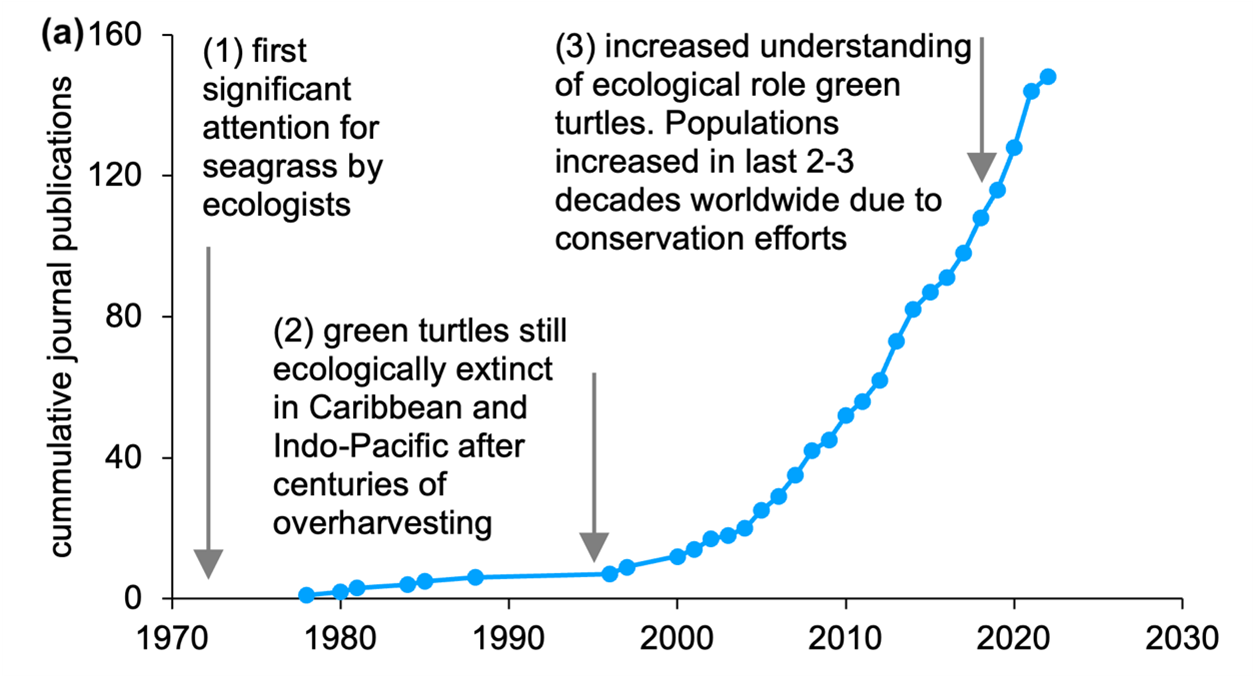Reviewed by Alex SmithNov 7 2022
A new study has shown that sea turtles have been overharvested in the past, leading to their threatened population status.
 The number of publications on seagrass and green turtle grazing in peer-reviewed journals is accelerating over time (Web of Science, Scopus, Google Scholar 1960-2022, SI text 1), mirroring the recovery of green turtle populations. Image Credit: Wageningen University & Research.
The number of publications on seagrass and green turtle grazing in peer-reviewed journals is accelerating over time (Web of Science, Scopus, Google Scholar 1960-2022, SI text 1), mirroring the recovery of green turtle populations. Image Credit: Wageningen University & Research.
However, for 20 years, their populations have been restored in a few areas worldwide, and their ecological role seems to be developing. The seagrass meadows they feed on are coming back to their naturally grazed state as an outcome. Few are even turning out to be overgrazed. The study questions how does the return of the sea turtle impact the functioning of coastal ecosystems?
A research group examined the seagrass ecosystem value (like coastal protection and carbon storage) ahead of a turtle grazing area from low to high. In experiments, they identified the effect of recovering sea turtle populations on ecosystem functioning.
The team, headed by Wageningen University, with collaborators from the Netherlands and the Dutch Caribbean, recently reported their outcomes in the Global Change Biology journal.
Seagrass meadows offer a range of goods and services. For instance, they offer habitat and food for several commercially significant fish species. Also, they help safeguard the coast by stabilizing sediments and decreasing wave energy.
With the coming back of the large herbivore—the sea turtle—it is essential to measure their effect on the ecosystem services a seagrass meadow could offer. Frequently, such services are quantified separately. However, in the new study, the most essential services have been evaluated collectively to estimate the multifunctionality of the ecosystem.
Combining Ecosystem Services on One Index
Our approach to measuring different ecosystem functions simultaneously and combining these in one ecosystem-multifunctionality-index is new for marine habitats and led to striking results.
Marjolijn Christianen, Study Lead Investigator, Wageningen University & Research
Christianen added, “We found that medium turtle grazing pressure increased carbon storage and nutrient cycling in seagrass meadows. On the other hand, fish biomass and other services were higher in meadows without turtle grazing. More importantly, we found a simultaneous collapse of all these services under severe turtle grazing pressure.”
Integrative Approach for Balanced Ecosystems
Depending on the outcomes obtained, the authors dispute that the profitable return of the sea turtle must be joined by the habitat’s safety, seagrass meadows, and their predators. This can impact turtle grazing behavior via fear effects.
“Based on recent insights from studies in the Bahamas, the resulting spatial variation in grazing pressure can probably prevent habitat collapse,” stated Fee Smulders, co-author of the study.
By taking an integrative ecosystem approach to management, we can maintain high ecosystem multifunctionality, as well as balanced ecosystems that can sustain natural densities of charismatic sea turtles.
Marjolijn Christianen, Study Lead Investigator, Wageningen University & Research
Pristine Seagrass Meadows
Green sea turtles are known to be the megaherbivores of the ocean. As their populations have been destroyed, researchers have turned out to be normal to studying and living in ungrazed seagrass meadows.
Such lush seagrass meadows controlled by sturdy species are considered healthy, in “pristine” condition, and very precious. However, with the return of the green sea turtle in several coastal areas in the past years—as a result of successful conservation—several seagrass meadows have been converted into grazed seascapes.
An earlier study reported in Nature, Ecology and Evolution by Wageningen scientists discussed how one should review the perspective of a pristine seagrass meadow. This probably comprises a mosaic of (heavily) grazed patches and ungrazed patches with higher biodiversity and high plant species diversity in general.
This mosaic seascape might be more natural, although the ecosystem value may be slightly lower than ungrazed meadows.
At present, the various grazing scenarios (low abundance, high turtle abundance, sometimes hyper-abundant) coincide in all three ocean basins where turtles are discovered; the results of such new studies are even more appropriate and immediate worldwide. Also, the findings can be utilized to forecast the ecosystem effects of shifts in the forthcoming days.
Journal Reference:
Christianean, M. J. A., et al. (2022) Seagrass ecosystem multifunctionality under the rise of a flagship marine megaherbivore. Global Change Biology. doi.org/10.1111/gcb.16464.